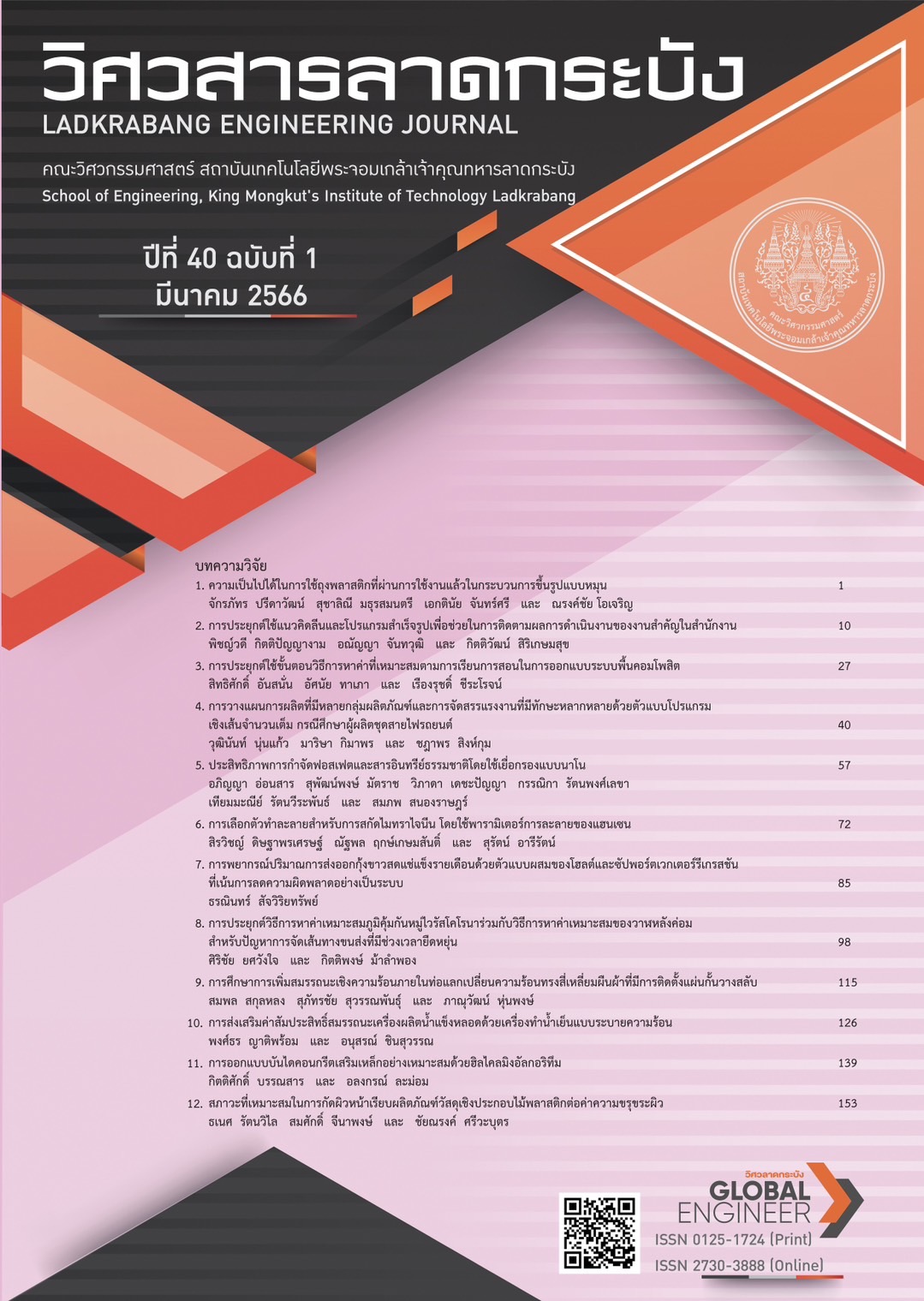Forecasting Monthly Export Volume of Frozen White Shrimp with Hybrid Model of Holt and Support Vector Regression Emphasizing on Systematic Error Reduction
Keywords:
Export, White shrimp, Hybrid model, Error reduction, Support Vector RegressionAbstract
Frozen white shrimp export plays a significant role in agricultural commodities in Thailand. However, agriculturists still encounter high production costs, which affect export competitiveness of Thailand. More than 90% of total production cost is variable cost, which corresponds to volume of white shrimp cultivation. The appropriate forecast of future export quantity of white shrimp can be useful information to support critical decision making on production planning. In this research, a hybrid model of Holt and support vector regression is developed emphasizing on systematic error reduction to improve accuracy of forecast. Moreover, the hybrid model is compared to conventional models (i.e., ARIMA and Holt-Winters) based on five accuracy measures. The empirical results indicated that the hybrid model outperforms other forecasting models. Furthermore, the forecasting performance of hybrid model approximates to the forecasting performance in test data used in cross-validation, although some new hidden observations are used. Consequently, the hybrid model can be a useful tool to support decision making on production of white shrimp in Thailand.
References
Office of Agricultural Economics, “Marine shrimp farming,” in Information of agricultural commodities 2021, Bangkok, Thailand: Office of Agricultural Economics, 2022. [Online]. Available: https://www.oae.go.th/assets/portals/1/files/jounal/2565/commodity2564.pdf
Frozen white shrimp export, Office of Agricultural Economics, Apr. 1, 2022. [Online]. Available: https://impexpth.oae.go.th/export.
Office of Agricultural Economics, “Export value of shrimps and product by trading partner, 2018-2020,” in Thailand foreign agricultural trade statistics 2021, Bangkok, Thailand: Office of Agricultural Economics, 2022. [Online]. Available: https://www.oae.go.th/assets/portals/1/files/jounal/2565/trade2564.pdf.
Office of Agricultural Economics, “Shrimp,” in Situation of agricultural commodities and trend 2022, Bangkok, Thailand: Office of Agricultural Economics, 2022. [Online]. Available: https://www.oae.go.th/assets/portals/1/files/jounal/2565/trendstat2565-Final-Download.pdf.
E. Rattanapun, “Cost and returns of pacific white shrimp”, Surat Thani Fisheries Provincial Office, Surat Thani, Thailand, Technical Paper No. 1/2019, Apr.2, 2019. [Online]. Available: https://hectortarr.arda.or.th/api/uploaded_file/ZJbM_14S_9I05ZOVoIsiB.
T. W. Yoo and I. S. Oh, “Time series forecasting of agricultural products’ sales volumes based on seasonal long short-term memory,” Applied Sciences, vol. 10, no. 22, 2020, Art. no. 8169, doi: 10.3390/app10228169.
Y. Ensafi, S. H. Amin, G. Zhang and B. Shah, “Time-series forecasting of seasonal items sales using machine learning–A comparative analysis,” International Journal of Information Management Data Insights, vol. 2, no. 1, 2022, Art. no. 100058, doi: 10.1016/j.jjimei.2022.100058.
K. Kurumatani, “Time series forecasting of agricultural product prices based on recurrent neural networks and its evaluation method”. SN Applied Sciences, vol. 2, pp.1–17, 2020, doi: 10.1007/s42452-020-03225-9.
S. K. Purohit, S. Panigrahi, P. K. Sethy and S. K. Behera, “Time series forecasting of price of agricultural products using hybrid methods,” Applied Artificial Intelligence, vol. 35, no.15, pp.1388–1406, 2021, doi:10.1080/08839514.2021.1981659.
Y. Zhu, Y. Zhao, J. Zhang, N. Geng and D. Huang, (2019). “Spring onion seed demand forecasting using a hybrid Holt-Winters and support vector machine model,” PloS one, vol. 14, no.7, 2019, Art. no. e0219889, doi:10.1371/journal.pone.0219889.
S. Wu, H. Han, B. Hou and K. Diao, “Hybrid model for short-term water demand forecasting based on error correction using chaotic time series,” Water, vol. 12, no. 6, 2020, Art. no. 1689, doi: 10.3390/w12061683.
M. Devi, J. Kumar, D. P. Malik and P. Mishra, “Forecasting of wheat production in Haryana using hybrid time series model,” Journal of Agriculture and Food Research, vol. 5, 2021, Art. no. 100175, doi: 10.1016/j.jafr.2021.100175.
R. J. Hyndman, G. Athanasopoulos, C. Bergmeir, G. Caceres, L. Chhay, K. Kuroptev and M. O'Hara-Wild Package ‘forecast’, Accessed: Mar. 2022. [Online].Available: https://cran.r-project.org/web/packages/ forecast/forecast.pdf.
S. Mohan, A. K. Solanki, H. K. Taluja and A. Singh, “Predicting the impact of the third wave of COVID-19 in India using hybrid statistical machine learning models: A time series forecasting and sentiment analysis approach,” Computers in Biology and Medicine, vol.144, 2022, Art. no. 105354, doi:10.1016/j.compbiomed.2022.105354.
H. Alabdulrazzaq, M. N. Alenezi, Y. Rawajfih, B. A. Alghannam, A. A. Al-Hassan and F. S. Al-Anzi, “On the accuracy of ARIMA based prediction of COVID-19 spread,” Results in Physics, vol. 27, 2021, Art. no. 104509, doi:10.1016/j.rinp.2021.104509.
G. Dudek and P. Pelka, “Pattern similarity-based machine learning methods for mid-term load forecasting: A comparative study,” Applied Soft Computing, vol.104 , 2021, Art. no. 107223, doi: 10.1016/j.asoc.2021.107223.
T. Sujjaviriyasup, “Hybrid Model of Support Vector Machine and Genetic Algorithm for Forecasting the Annual Peak Electricity Demand of Thailand,” The Journal of KMUTNB, vol. 27, no. 3, pp.453–465, 2017.
D. Meyer, E. Dimitriadou, K. Hornik, A. Weingessel, F. Leisch, C. -C. Chang and C. -C Lin, Package ‘e1071’, Accessed: Mar. 2022. [Online]. Available: https://cran.r-project.org/web/packages/e1071/e1071.pdf.
N. Wei, C. Li, X. Peng, F. Zeng and X. Lu, (2019). “Conventional models and artificial intelligence-based models for energy consumption forecasting: A review,” Journal of Petroleum Science and Engineering, vol. 181, 2019, Art. no. 106187, doi: 0.1016/j.petrol.2019.106187.
Downloads
Published
How to Cite
Issue
Section
License
Copyright (c) 2023 Faculty of Engineering, King Mongkut’s Institute of Technology Ladkrabang

This work is licensed under a Creative Commons Attribution-NonCommercial-NoDerivatives 4.0 International License.
The published articles are copyrighted by the School of Engineering, King Mongkut's Institute of Technology Ladkrabang.
The statements contained in each article in this academic journal are the personal opinions of each author and are not related to King Mongkut's Institute of Technology Ladkrabang and other faculty members in the institute.
Responsibility for all elements of each article belongs to each author; If there are any mistakes, each author is solely responsible for his own articles.






